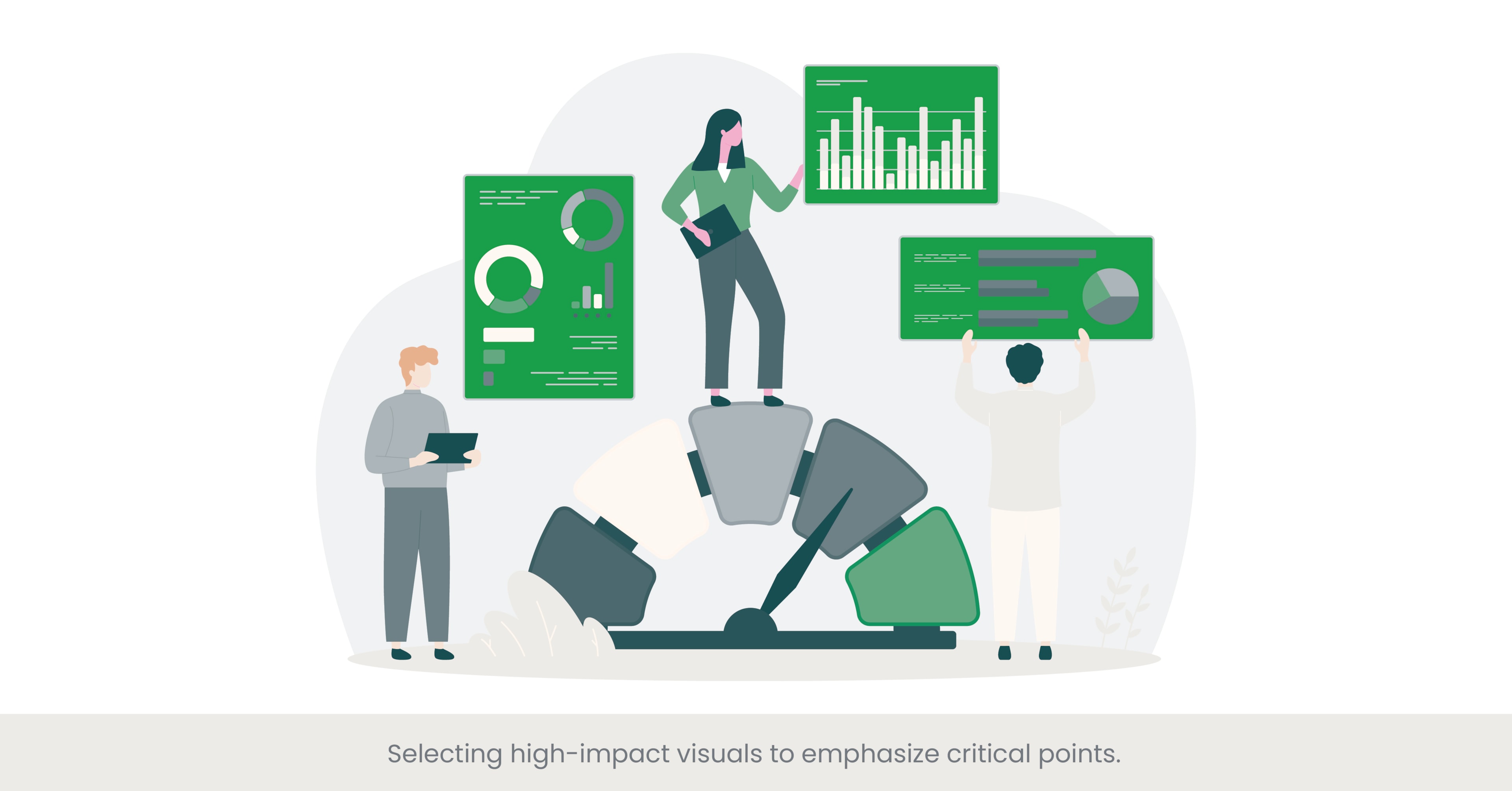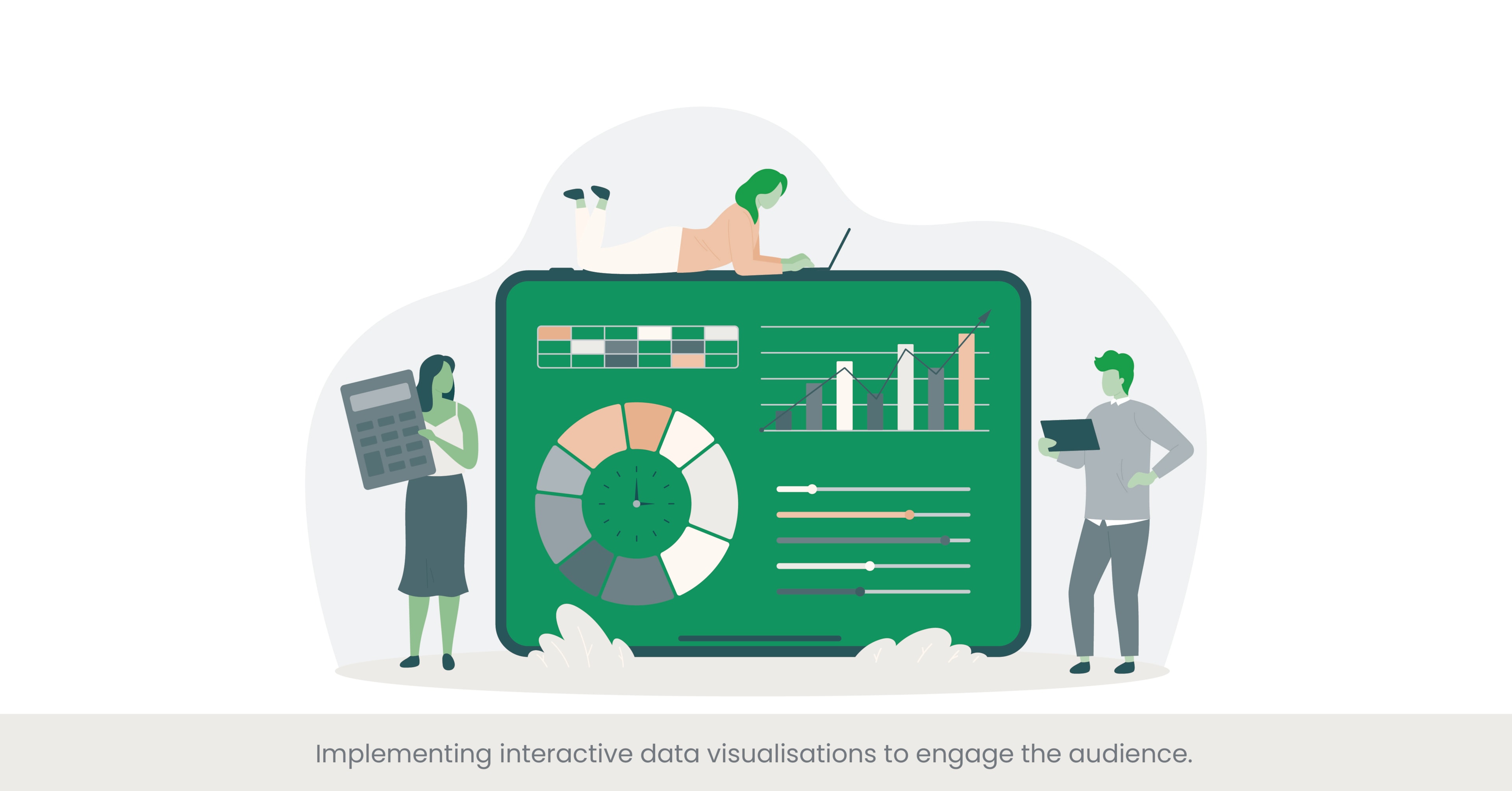
Selecting High-Impact Visuals to Emphasize Critical Points

Introduction
Selecting high-impact visuals to emphasize critical points is an essential strategy in CEO presentations. High-impact visuals capture the audience’s attention and highlight the most important messages, making the presentation more engaging and memorable. These visuals can include charts, graphs, images, and infographics that are designed to convey information quickly and effectively. This sub-topic explores how to choose and use high-impact visuals to enhance the effectiveness of CEO presentations.
Background Information
The importance of high-impact visuals in presentations is well-documented in communication and educational research. Visuals help to break down complex information into more digestible parts, making it easier for the audience to understand and retain key messages. High-impact visuals are those that are visually striking and directly relevant to the content, helping to emphasize critical points without overwhelming the audience. Historical examples include the use of pie charts, bar graphs, and line charts in business presentations, which have evolved with technology to include more sophisticated data visualizations. Understanding the principles of design and visual communication is crucial for selecting the right visuals to support your presentation.
Real-World Examples
A prime example of effective use of high-impact visuals is Steve Jobs' presentations for Apple product launches. Jobs used simple, bold visuals to highlight the key features and benefits of new products, ensuring that the audience's attention was focused on the most critical points. Another example is Mary Barra, CEO of General Motors, who uses high-impact visuals to illustrate complex automotive technologies and market strategies. Her presentations often feature detailed infographics and charts that break down technical information into easily understandable segments. These examples demonstrate how high-impact visuals can enhance the clarity and impact of CEO presentations.
Designing Infographics that Distill Complex Data into Digestible Insights

Introduction
Designing infographics that distill complex data into digestible insights is a powerful technique in CEO presentations. Infographics transform detailed and intricate information into visually engaging formats that are easy to understand and retain. By using infographics, CEOs can present complex data in a way that highlights key insights and supports strategic messages effectively. This sub-topic explores the principles and practices of designing effective infographics for executive presentations.
Background Information
Infographics have become a popular tool in business communication due to their ability to simplify and clarify complex information. Historically, infographics have been used in various fields, including journalism, education, and marketing, to present data in a visually appealing and accessible manner. Key principles of effective infographic design include clarity, simplicity, and relevance. Infographics should be designed to highlight the most important data points and insights, using visual elements such as charts, icons, and color coding to enhance understanding. Understanding these principles is crucial for creating infographics that effectively communicate complex data in CEO presentations.
Real-World Examples
A notable example of effective infographic design is the annual financial reports presented by companies like Tesla. Elon Musk, CEO of Tesla, often uses infographics to illustrate key financial metrics and market trends, making complex financial data accessible to stakeholders. Another example is the presentations by Sundar Pichai, CEO of Google, who uses infographics to explain complex technological advancements and data-driven strategies. These infographics break down complex information into clear, concise visuals that highlight the most critical insights. These examples demonstrate how well-designed infographics can enhance the effectiveness of CEO presentations by distilling complex data into digestible insights.
Using Data-Driven Stories to Substantiate Strategic Directions

Introduction
Using data-driven stories to substantiate strategic directions is a crucial technique in CEO presentations. Data-driven stories combine the power of narrative with the precision of data to create compelling and persuasive arguments. By grounding strategic directions in concrete data, CEOs can enhance their credibility and make a stronger case for their decisions and plans. This sub-topic explores how to effectively use data-driven stories to support strategic messaging in executive presentations.
Background Information
The concept of data-driven storytelling has gained prominence with the rise of big data and analytics. Traditionally, storytelling has been used to make otherwise abstract concepts and ideas relatable and memorable. In the business context, integrating data into stories helps to substantiate claims with empirical evidence, providing a solid foundation for strategic decisions. Key elements of data-driven storytelling include identifying relevant data, crafting a coherent narrative, and using visualizations to highlight key insights. This approach not only makes the data more accessible but also helps to convey the strategic implications clearly and persuasively.
Real-World Examples
One notable example of using data-driven stories is Satya Nadella, CEO of Microsoft. Nadella often incorporates data-driven narratives in his presentations to illustrate the impact of Microsoft's strategies on cloud computing and artificial intelligence. By using concrete data points and visualizations, he effectively communicates the company's progress and future direction. Another example is Sheryl Sandberg, COO of Facebook, who uses data-driven stories to highlight the company’s achievements in user engagement and advertising revenue. These narratives, supported by robust data, help to build a compelling case for Facebook's strategic initiatives. These examples demonstrate how data-driven stories can substantiate strategic directions and enhance the persuasiveness of CEO presentations.
Customizing Visual Themes to Match the Tone of the Message

Introduction
Customizing visual themes to match the tone of the message is a critical aspect of CEO powerpoint presentations themselves. The visual theme encompasses elements such as color schemes, typography, and overall design style, which collectively convey the powerpoint presentation design's mood and support its narrative. Tailoring these elements to align with the tone of the message ensures that the visuals enhance rather than detract from the content, making the presentation more cohesive and impactful. This sub-topic explores how to customize visual themes effectively to reinforce the a powerpoint presentation design's message.
Background Information
The concept of visual themes in presentations is rooted in the principles of design and communication. Historically, visual themes have been used in various forms of media to create a specific atmosphere and support the narrative. In the context of CEO presentations, visual themes should reflect the message's tone, whether it is serious, inspirational, innovative, or celebratory. Key elements include selecting appropriate color palettes, fonts, and graphic styles that resonate with the intended audience and message. Understanding the psychological impact of design elements and their ability to convey different tones is essential for creating effective visual themes.
Real-World Examples
A notable example of customizing visual themes is the keynote presentations by Tim Cook, CEO of Apple. Apple’s presentations often feature sleek, minimalist designs with a futuristic feel, reflecting the company’s emphasis on innovation and cutting-edge technology. The consistent use of black and white themes with occasional splashes of color helps to maintain a professional yet modern tone. Another example is Howard Schultz, former CEO of Starbucks, whose keynote presentations often use warm, earthy tones and hand-drawn elements to convey a sense of community and sustainability, aligning with Starbucks’ brand values. These examples illustrate how a creative team and customizing visual themes to match the tone of the message can enhance the effectiveness of CEO presentations.
Implementing Interactive Data Visualizations to Engage the Audience

Introduction
Implementing interactive data visualizations to engage the audience is a cutting-edge approach in CEO presentations. Interactive visualizations allow the audience to explore data dynamically, making the presentation more engaging and informative. This technique involves using tools and technologies that enable real-time interaction with data, such as interactive charts, maps, and dashboards. By incorporating interactive elements, CEOs can create more compelling and engaging presentations that foster a deeper understanding of the content. This sub-topic explores how to effectively implement interactive data visualizations in executive presentations.
Background Information
Interactive data visualizations have gained prominence with the advent of advanced data visualization tools and technologies. Traditionally, presentations relied on static visuals, which limited the audience's ability to interact with the data. Interactive visualizations, on the other hand, allow users to manipulate data in real-time, providing a more immersive experience. Key elements of effective interactive visualizations include user-friendly interfaces, responsive design, and meaningful data interactions. These elements help to create a more engaging and informative presentation experience. Understanding the principles of interactive design and the capabilities of modern data visualization tools is crucial for effectively implementing interactive visualizations in presentations.
Real-World Examples
A notable example of using interactive data visualizations is Jeff Bezos, former CEO of Amazon, who often uses interactive dashboards during his presentations to illustrate Amazon's financial performance and market trends. These dashboards allow stakeholders to explore different data points and scenarios dynamically. Another example is Satya Nadella, CEO of Microsoft, who incorporates interactive visualizations in his presentations to demonstrate the capabilities of Microsoft’s cloud computing and AI technologies. These interactive elements help to engage the audience and provide a deeper understanding of the complex data. These examples highlight how interactive data visualizations can enhance audience engagement and comprehension in CEO presentations.
Aligning Visual Content with the Overall Branding of the Company

Introduction
Aligning visual content with the overall branding of the company is essential for creating cohesive and professional CEO presentations. Consistency in branding helps to reinforce the company’s identity and values, making the presentation more recognizable and trustworthy. This involves using the company’s official colors, fonts, logos, and design elements throughout the presentation. By ensuring that all visual content aligns with the corporate branding, CEOs can create a unified and impactful presentation that resonates with the audience. This sub-topic explores how to effectively align visual content with corporate branding.
Background Information
The importance of brand consistency in visual content is well-established in marketing and design principles. Historically, companies with strong brand identities have maintained consistent visual elements across all communication channels, including presentations. This consistency helps to build brand recognition and trust among stakeholders. Key elements of aligning visual content with branding include using the company’s color palette, typography, and logo consistently throughout the presentation. Additionally, the overall, powerpoint presentation design and style should reflect the company’s brand personality and values. Understanding the principles of branding and visual identity is crucial for creating presentations that are cohesive and aligned with the company’s brand.
Real-World Examples
A prime example of aligning visual content with corporate branding is Coca-Cola’s presentations. Coca-Cola consistently uses its signature red color, white font, and iconic logo in all its presentations, ensuring that the visual content is immediately recognizable and aligned with its brand identity. Similarly, IBM uses its blue color palette, modern typography, and minimalist design style in its presentations, reflecting its emphasis on innovation and professionalism. These examples illustrate how aligning visual content with corporate branding can enhance the impact and professionalism of CEO presentations.
Employing Contrasting Colors to Draw Attention to Key Statistics

Introduction
Employing contrasting colors to draw attention to key statistics is an effective strategy in CEO presentations. The strategic use of color contrast helps to highlight important data and bullet points, making them stand out and ensuring that the audience quickly grasps the critical information. This technique not only enhances the visual appeal of the presentation but also guides the audience’s focus to the most significant statistics and insights. This sub-topic explores how to use contrasting colors effectively to emphasize key statistics in executive presentations.
Background Information
The psychology of color and its impact on visual communication has been extensively studied. Historically, designers and communicators have used color contrast to create emphasis and draw attention to specific elements. In the context of presentations, contrasting colors can be used to differentiate important data points from the rest of the content, making them more noticeable. Key principles include using high-contrast color combinations, such as dark text on a light background or bright colors against neutral tones, to ensure readability and visual impact. Understanding these principles is essential for effectively using color to highlight key statistics in presentations.
Real-World Examples
A notable example of employing contrasting colors effectively is Elon Musk’s presentations for Tesla. Musk often uses bold colors to highlight key statistics, such as sales figures and technological advancements, against a clean, minimalist background. This approach ensures that the critical data stands out and captures the audience’s attention. Another example is Shantanu Narayen, CEO of Adobe, who uses contrasting colors in his presentations to emphasize important metrics and strategic goals. By using bright, contrasting colors, Narayen ensures that key statistics are easily identifiable and memorable. These examples demonstrate how the strategic use of contrasting colors can enhance the clarity and impact of CEO presentations.
Integrating Video Elements to Break Up Data Presentations

Introduction
Integrating video elements to break up data presentations is a dynamic strategy in CEO presentations. Videos can provide a welcome change of pace, making the presentation more engaging and less monotonous. By incorporating video clips, CEOs can illustrate complex concepts, showcase success stories, or provide visual evidence to support their points. This sub-topic explores how to effectively use video elements to enhance the impact and engagement of executive presentations.
Background Information
The use of videos in presentations has increased significantly with advancements in multimedia technology. Videos can convey information more vividly than static images or text, making them an effective tool for communication. Historical data shows that presentations incorporating videos can increase audience engagement and retention. Key principles for integrating video elements include ensuring relevance to the topic, keeping videos concise, and maintaining high production quality. Videos can serve various purposes, such as introducing new topics, providing case studies, or summarizing key points. Understanding these principles is essential for using videos effectively in presentations.
Real-World Examples
A prime example of integrating video elements effectively is Marc Benioff, CEO of Salesforce. During Salesforce’s annual Dreamforce conference, Benioff uses video testimonials from customers and partners to illustrate the impact of Salesforce’s solutions. These videos provide real-world evidence and add authenticity to the presentation. Another example is Mary Barra, CEO of General Motors, who uses videos to showcase new vehicle models and technological innovations during product launches. These videos help to visualize complex automotive technologies and enhance the overall impact of the presentation. These examples demonstrate how integrating video elements can break up data presentations and make them more engaging and impactful.
Ensuring Visuals Are Accessible to All Audience Members

Introduction
Ensuring visuals are accessible to all audience members is a critical aspect of CEO presentations. Accessibility in visual presentation design service, means that all audience members, including those with disabilities, can fully engage with and understand the presented content. This includes considerations for visual impairments, color blindness, and cognitive disabilities. By making visuals accessible, CEOs can ensure that their messages reach and resonate with the widest possible audience. This sub-topic explores the principles and practices for creating accessible visual content in executive presentations.
Background Information
The concept of accessibility in design has its roots in inclusive practices that aim to provide equal access to information and communication. In the context of presentations, accessibility involves using high-contrast colors, readable fonts, and descriptive text for images and charts. It also includes providing alternative text for visuals, using clear and simple language, and ensuring that all visual elements are distinguishable by those with color vision deficiencies. These practices are guided by standards such as the Web Content Accessibility Guidelines (WCAG), which provide detailed criteria for making digital content accessible. Understanding these principles is essential for creating inclusive presentations.
Real-World Examples
A notable example of ensuring accessibility in presentations is Satya Nadella, CEO of Microsoft. Nadella emphasizes accessibility in all aspects of Microsoft's products and presentations, often using high-contrast visuals, clear typography, and detailed descriptions for all visual elements. Another example is Tim Cook, CEO of Apple, who integrates accessibility features into Apple's product launch presentations, ensuring that all videos are captioned and that other visuals used are designed with high contrast and readability in mind. These examples highlight the importance of accessibility in creating presentations that are inclusive and engaging for all audience members.
Preparing Visuals That Can Adapt to Different Presentation Environments

Introduction
Preparing visuals that can adapt to different presentation environments is crucial for ensuring the effectiveness and professionalism of CEO presentations. Presentation environments can vary widely, from large conference halls with projectors to small meeting rooms with flat screens, and even virtual settings. Visuals must be designed to be flexible and clear across these different formats to maintain their impact. This sub-topic explores strategies for creating adaptable visuals that perform well in any setting.
Background Information
The need for adaptable visuals has grown with the increasing variety of presentation environments. Historically, presentations were often confined to specific venues, but modern business demands flexibility. Key elements of adaptable visuals include scalable graphics, high-resolution images, and flexible layouts that maintain clarity regardless of screen size or resolution. Additionally, presentations should be designed to be compatible with various software platforms such as PowerPoint, Google Slides, and other presentation tools. Understanding the technical and design principles that enable adaptability is essential for creating visuals that are effective in any setting.
Real-World Examples
A prime example of preparing adaptable visuals is the approach taken by Google during their annual I/O conferences. Sundar Pichai, CEO of Google, ensures that all presentation visuals are designed to be clear and impactful on both large conference screens and smaller, virtual viewing devices. Similarly, Indra Nooyi, former CEO of PepsiCo, used visuals that were effective in various presentation settings, from intimate board meetings to large shareholder meetings. These visuals were designed with flexibility in mind, ensuring that key messages were consistently communicated regardless of the environment. These examples demonstrate the importance of preparing adaptable visuals to maintain the effectiveness of CEO presentations across different settings.
FAQs
1. How to prepare a presentation for CEO?
To prepare and complete a presentation for a CEO, focus on clarity, conciseness, and relevance. Start with a clear objective and structure the content to highlight key points. Use high-quality visuals and data to support your message, ensuring that they align with the CEO's strategic goals. Practice your delivery to maintain confidence and be prepared to answer questions. Utilize presentation design services or a CEO keynote design agency to ensure a professional finish.
2. How to present to C-level executives?
When presenting to C-level executives, keep your content concise and focused on high-level insights. Use data-driven stories and impactful visuals to support your key points. Tailor your message to align with the executives' strategic priorities and address potential concerns. Engage the audience with interactive elements and be prepared for in-depth questions. Using services from a CEO presentation design expert can help refine your presentation for maximum impact.
3. Who is a presentation designer?
A presentation designer is a professional who specializes in creating visually engaging and effective presentation materials. They use design principles and tools like PowerPoint, Google Slides, and other software to develop slides that communicate information clearly and persuasively. Presentation designers often work with corporate executives, including CEOs, to ensure that presentations are visually appealing and aligned with the company's branding and messaging.
4. What is an executive presentation?
An executive presentation is a high-level presentation typically delivered to senior management or board members. It focuses on strategic issues, performance metrics, and key initiatives. The content is usually concise, data-driven, and supported by high-impact visuals. Executive presentations aim to inform, persuade, and facilitate decision-making at the highest levels of the organization. Employing a CEO keynote design agency or presentation design expert can enhance the effectiveness of an executive presentation.
5. How do you make a presentation design engaging?
To make a website or presentation design engaging, use high-quality visuals, consistent branding, and clear, concise text. Incorporate interactive elements like videos or interactive charts to maintain audience interest. Ensure that the design is clean and uncluttered, complete with a focus on key messages and ideas. Employing contrasting colors to highlight important points and using a professional presentation designer can significantly enhance engagement.
6. What tools can be used for creating professional presentations?
Several tools can be used for creating professional presentations, including Microsoft PowerPoint, Google Slides, and Apple Keynote. These platforms offer a range of features for creating high-quality slides, including custom templates,, animations, and data visualization tools. For more advanced presentation design services and needs, tools like Adobe Illustrator and Canva can also be used. Working with a presentation designer or CEO keynote design agency can help you leverage these tools effectively.
7. Why is branding important in a presentation?
Branding is important in a presentation because it reinforces the company's identity and values, making the presentation more recognizable and trustworthy. Consistent use of colors, fonts, logos, and other design elements helps to create a cohesive and professional appearance. This consistency builds brand recognition and ensures that the presentation aligns with the overall corporate image. A presentation design expert can ensure that all visual content aligns with the company’s branding.
8. How can you ensure accessibility in presentation design?
To ensure accessibility in presentation design, use high-contrast colors, readable fonts, and clear, simple language. Provide alternative text for images and charts, and ensure that all visual elements are distinguishable by those with color vision deficiencies. Consider providing captions for videos and using tools that support screen readers. Adhering to guidelines such as the Web Content Accessibility Guidelines (WCAG) can help ensure that your presentation is accessible to all audience members.
9. What are interactive data visualizations and why are they useful?
Interactive data visualizations are graphical representations of data that allow users to interact with the information in real-time. These visualizations can include interactive charts, maps, and dashboards that let users explore data by zooming, filtering, and clicking on elements to get more details. They are useful because they engage the audience more effectively, making complex data easier to understand and analyze. Interactive visualizations can be particularly impactful in CEO presentations, helping to illustrate key points dynamically.
10. How do you tailor a presentation for different audiences?
Tailoring a presentation for different audiences involves understanding the target audience's needs, interests, and level of expertise. Adjust the content to be relevant and meaningful to the specific audience, using language and examples that resonate with them. Customize the visuals and design elements to align with the target audience's expectations and preferences. Practicing the presentation and gathering feedback can also help ensure that it meets the target audience's needs effectively. Utilizing a presentation design service can assist in tailoring the presentation to different audience segments.



%20(1).jpg)
%20(1).jpg)


